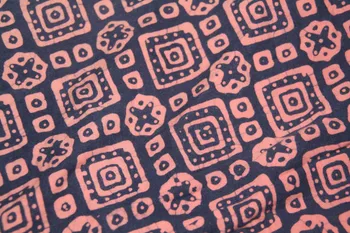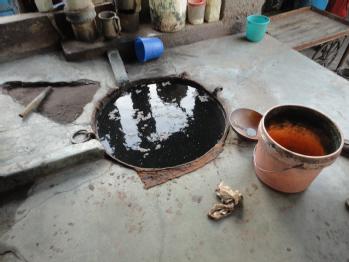Qasim Haji Musa
(Shakeel’s Father)
|
Age: 58 Education: Class 7 Occupation: batik printer Date of interview: 28/5/2012, Mundra
|
Boiling vessel for batik wax |
Interview Summary
When we visited the batik printing workshop, Shakeel’s father showed us the equipment and explained the process involved in batik. He explained that the white cloth is de-starched by soaking the fabric overnight. It is then stone-washed and kept it in a large pot call a kundi, and further soaked in soda water, to soften the fabric. Since soaking and washing use a great deal of water, the workshop needs to have a proper drainage system. After washing, the fabric is hanged on bamboos call lath which allow the excess water to drain away. This method avoids wringing the cloth, which may smudge the colour. Below the lath, moulded iron sheets are fixed through which water drips and accumulates in a large water container. A similar washing process is also followed, with the kundi filled with soap, to later remove the wax.
 For the wax-making process, wax is boiled at extremely high temperatures. To achieve this, a two-tiered structure is used. Wax is kept in a vessel above a brick furnace at ground level. Qasim explained that since wax has a lighter density (ghanata) then the water, when boiled it forms on the surface of the vessel, like butter from milk. The unused melted wax is moulded together for reuse. Printing is done on the sand-filled pad. The dyeing method varies according to the number of different designs on a piece, but completing a single batik cloth is a laborious process.
For the wax-making process, wax is boiled at extremely high temperatures. To achieve this, a two-tiered structure is used. Wax is kept in a vessel above a brick furnace at ground level. Qasim explained that since wax has a lighter density (ghanata) then the water, when boiled it forms on the surface of the vessel, like butter from milk. The unused melted wax is moulded together for reuse. Printing is done on the sand-filled pad. The dyeing method varies according to the number of different designs on a piece, but completing a single batik cloth is a laborious process.
Qasim says that their workshop is between 20 and 25 years old, although the art form in the region itself is approximately 90 to 100 years old. The wall of their workshop is studded with numerous blocks, both old and new. The blocks are made by both local workers and in Pethapur, near Ahmadabad. Designs are traced onto vertically-chopped wood to make the blocks. Teak is the preferred type of wood as it rarely flexes or cracks.
The local market for their goods used to be limited: they produced only sadla (saris), putara (duppata) and in Qasim’s words these were ‘maryadit’; limited to certain castes. In those days, Qasim says that the position of the workers was poor. Both foreign and Indian sales have more recently increased due to changes in fashion, and they now effectively work as wholesalers. Soft-spoken Qasim Haji is not only humble, but possesses an in-depth knowledge of his art form. His command over the language is also impressive.

